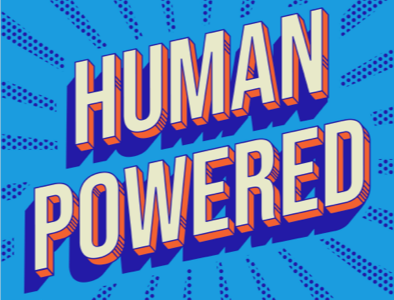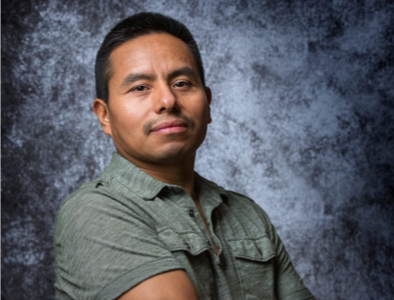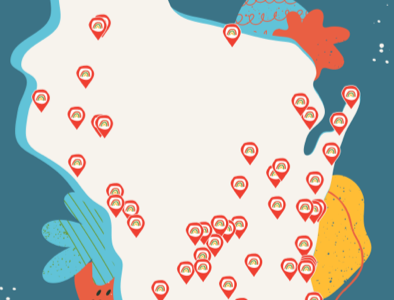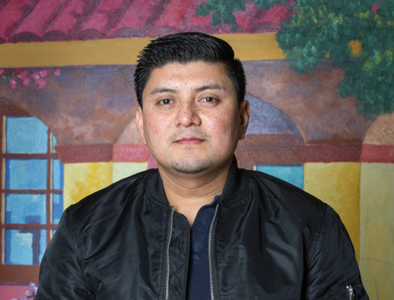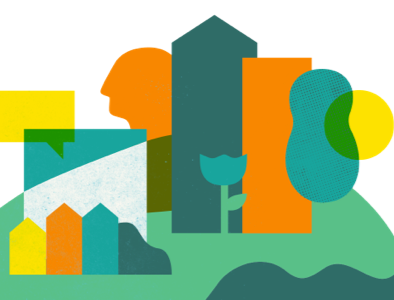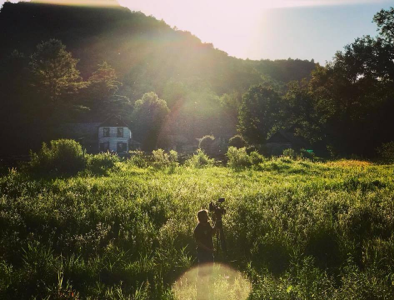Spring 2021 Newsletter
A Conversation with Jimmy Gutierrez
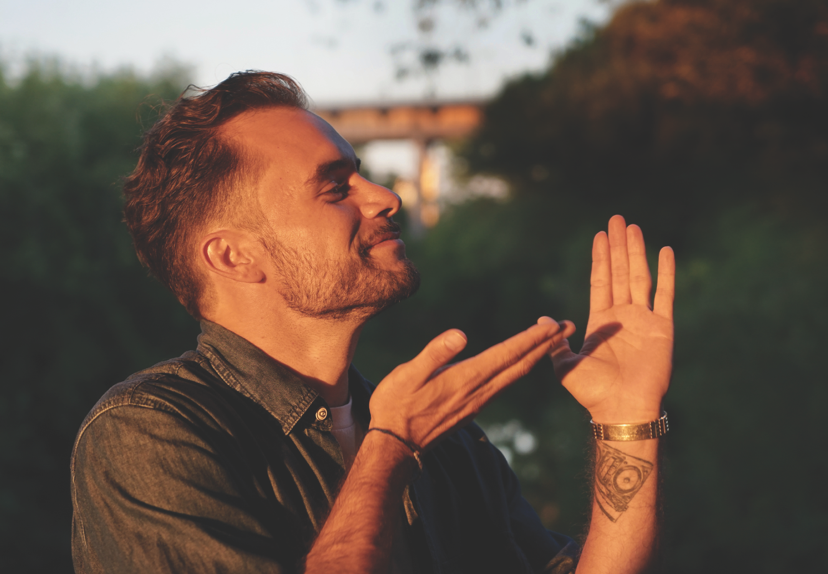
Photos courtesy of Jimmy Gutierrez
We’re thrilled to share this Q&A with Jimmy Gutierrez, the host of our new podcast, Human Powered. Jimmy is also a Milwaukee-based journalist whose work takes an exciting, community-centered approach. Both roles are all about connecting with people through deep, sustained listening.
WH: What part of Milwaukee are you from? Tell us a little bit about growing up in the city.
JG: I’m from all over the South Side. There isn’t just one particular place I'm from, but I would say that my heart is in Burnham Park, a majority Latinx neighborhood. I'm second generation Mexican American, but I am also white, and white-passing. So that is a privilege I've gone through life with.
I played a lot of sports growing up. I spent a lot of time on basketball courts—there are so many, from KK Park to McGovern, to my alley. If you found a chain net, you were in heaven. I think the basketball court was a really interesting place to be socialized. In Milwaukee, it was such a multicultural, multiracial experience. I didn't realize how much those experiences shaped me. We would all learn from each other, but it was kind of shrouded, like "We're just playing sports, and we're just having fun." But actually, we were learning about each other, about where we all came from, race, class, family dynamics.
I went to UW-Madison for college. That was a shocking experience for me. It was the whitest experience I’d had up until that point; the campus was over 90% white. My schools had been multicultural and multiracial my whole life.
My senior year of high school, two of my best friends were shot and killed in Milwaukee. As an 18-year-old boy socialized not to deal with or process emotions and trauma, that was still sitting in me, and there was a lot of anger. Being in Madison, it was the first place I heard people use racial epithets maliciously. And regularly. That triggered a lot of that anger in me. So after my freshman year, I came back to Milwaukee. I was just kind of floating, trying to figure out what I wanted to do.
I transferred to UW-Milwaukee, and was in their business school, and I remember the conversations that we were having felt so hollow. It all felt so disconnected from my community, and not true to myself. I remember the day so vividly that I was walking on campus, and I saw the J-School. I was watching a lot of documentary film, dreaming of that work, and I just walked in and I was like, "How do I change my major? I want to be a journalist."
WH: How did your career in journalism begin?
JG: I interned across Milwaukee, and I wanted to be associated with a newsroom that I felt wasn't doing harm. The only place I felt really comfortable was Milwaukee Neighborhood News Service. They were highlighting the good in the community, and the work they were doing was actionable. That's something I think a lot of journalists shy away from. But I wanted to see that, if we're reporting on lead, our public officials are being held accountable, and the time we're spending making phone calls, asking people to share their trauma, isn’t in vain.
I became disenchanted with journalism because I wanted some immediate gratification for the work I was doing. I wanted to see change happen. I remember getting a phone call about joining the fire department. I forgot I even applied, honestly, because there was a years-long hiring freeze. I still had this idea of media, and information sharing, and being a part of a community and helping to share community stories.
I graduated with the 10-13-14 recruit class from the city’s fire academy. Graduation night, my classmates asked me to speak and represent our class. It’s still a highlight of my life. I was assigned to Engine 32 on 30th and Galena, which was right around the corner from a good friend’s auto body shop that I would spend summer days at working on my car as a teen. I was excited to serve the city in new ways.
But the fire department, like any institution, had its own issues. It was 80% male, heavily white, a lot of people from outside of the city. A lot of unchecked racial bias. A lot of sexism. And these issues were structural. I was like, "Can I spend my career fighting upstream? How long until I burn out?” I wondered if journalism was still an option for me. And luckily, it was.
I got recruited out to New Hampshire Public Radio. New Hampshire was the last place in the U.S. I ever expected to work. I thought it would be a good challenge, especially a place that was so white, a place that was so rural. And it was—it challenged me and stretched me.
After trying to lead initiatives to be more responsive to the community, I just realized that New Hampshire Public Radio was still the old guard, as far as how things are done: top-heavy executive leadership management, underfunded and under-resourced reporters and producers that have to fight way too hard to reflect what people actually want, and what would serve them. That's when I came back home to Milwaukee and took a job that was, start to finish, focused on deep listening.
WH: As a journalist, you’re committed to listening deeply to the communities you serve. What does that mean, in practice?
JG: Deep listening means that before you start any journalism project, you're seeking out the community's voice and the community's opinion. You have actual relationships with the community, and you're working in collaboration with them, asking yourself and them, “Is this what they want to see? Is this how they would say something? What is the best method to deliver this information?”
Until you do that, it's really difficult to develop trust with the community you’re serving, especially communities of color who don't have trust in traditional media, for good reason.

Jimmy and a friend hand out information and supplies at a Juneteenth event in 2020.
WH: Tell us about the project you’re currently working on.
JG: I'm working with a team of two other people, and we’re funded by Stanford University's John S. Knight Fellowship to address info needs in Milwaukee. I'm working in one specific neighborhood—Metcalfe Park. What I'm doing is asking the community, “What information do you want? What information would make your life better? How would you like to receive that information?”
What we’ve found, unsurprisingly, is that a lot of people want positive news. They want the media to be in the community when it's not just a tragedy. They want to actually show how people live their lives, to highlight the guy at the end of the block who plows the entire alleyway for free.
Communities also want news that improves their quality of life. We've heard a lot about the need for information on COVID, unemployment, housing, beautification efforts, how to deescalate arguments, how to support Black businesses.
We've surveyed about 50 people from the community as far as how they would like to receive that information. What we heard was that people wanted a newsletter. They wanted something brought to their door that was easy to read. A number of people said, “Just bring it to me; don't make me have to go and find it." So that's what we did. We're also working on a digital copy of the newsletter that our neighborhood community partners will share on Facebook and social media.
To do this work, it’s critical to have relationships with people who live in the community. I don't live in Metcalfe Park. What I know about Metcalfe Park is where it is geographically; I don't have the experiences of people who live there. So having trusted partners was critical. When we come to people in the neighborhood through someone they trust, they’re a lot more receptive to the questions we're asking and the conversations we want to have. For example, Richard Clark is one of our resident advisors. He’s incredible. He's 70, and he organizes people on his block to vote, to help clean up city properties. When a newsletter is about to publish, I give him a call and say, "Hey, what do you think? What would you add? What would you like to see?"
WH: What advice would you give to someone who is searching for the right community partners?
JG: I would say adjust your expectations, because it's slow work. You have to have a relationship with people before you start asking for things. I’ve had a relationship with one of our community partners, Melody, since last year. It's very slow work to build up that trust, especially in communities of color in a city as segregated as Milwaukee, and depending on what name you're bringing with you—if it's a newspaper or a TV station—if you're attached to those entities, it could be even slower going. But it's all about relationships.
Not everyone is made to do this. It's important to have self-awareness and understand your lane. If your newsrooms don't reflect the community before you even start an initiative, then work on your newsroom. The starting point, very often, is just being self-aware and self-reflective about your own shortcomings as an operation, as a newsroom, and addressing that before you start looking for community partners.

Delivering copies of the neighborhood newsletter—with pandemic precautions, of course.
WH: What is your ultimate goal for this project?
JG: This is one of many journalism models that I hope can be more reflective of communities. My goal is not to keep running this newsletter; it’s to find someone from the community who’s interested in what we're doing, train them on how to do it, and to be able to have this be, one day, 100% community controlled.
Next, maybe we’ll talk with folks in the LGBTQ community, or the undocumented community, or maybe another geographical community within Milwaukee. There are so many marginalized groups that don't have proper info shares. And the final product might not be a newsletter. If we're talking about undocumented folks, maybe it's a WhatsApp, or a weekly message or conversation.
Journalism is a public good. It has a role to play in democracy by empowering all people and holding the government accountable, holding elected officials accountable. The question is, does that happen? Is it a reflection of our population? I think we know that answer is no. But that doesn't mean that it doesn't have a role to play.
The information people need depends on so many things: race, socioeconomic status, sexual orientation, gender, immigration status. When you’re trying to figure out what those things are, you have to be tuned into a community. That's the value that journalism is supposed to provide.
WH: As the host of our new podcast, Human Powered, you’ve heard stories from people all over Wisconsin who are working hard to improve the places they call home. Why do stories like these matter? What does it mean to you, personally, to be involved in the podcast?
JG: I grew up very Milwaukee-centric, and I didn't go on a lot of vacations around the state. Hosting the podcast has opened up the state for me. It has brought so much to life that I didn't know about.
I can talk about the Driftless Region, and Stories from the Flood, which is an oral history project that lets people tell their stories about what happened during the 2018 floods, but also what it was like growing up in the Driftless and knowing that the floods are getting exponentially worse and increasing both in intensity and frequency. The landscape is so beautiful, but to residents it’s also a reminder of something tragic and terrifying, where people have PTSD and it's triggered when it starts to rain.
That's a history I didn't know. I love to go to the Driftless Region because it's different from any place in Wisconsin, and I love the microclimates and the cheese, honestly. But to hear from people who have 80 years of experience in the community—it changes you. It changed me, in the way I relate to the state.
These are sound-rich, narrated stories where you get to know the characters, you get to see them develop, to understand their motivations. You spend time with them, and you spend time in their region. I think that lends itself to a different sort of connection. You can hear yourself in someone from the Fox Valley, or the Driftless Region, or Milwaukee. You can see this connective fiber that is all across the state. Everyone has their challenges, and every community is trying to figure out the solutions together.
Wisconsin Humanities has a brand-new podcast!
We’ve put together a fantastic team to help us tell beautifully produced, emotionally powerful stories about how people make places better across our state. One of the people you’ll meet is Cheri Fuqua, a community leader and organizer.
In 2019, we launched Immigrant Journeys from South of the Border—an exhibit that shares the stories of eight immigrants who now live and work in Wisconsin. During this period of social and physical distancing, we believe this conversation must continue.
“Mary spent her life bringing people together and supported Wisconsin Humanities because she believed its programs and initiatives were so effective in providing public forums for civic dialogue among people of all persuasions, something she felt was so necessary for us all.”
We were honored to award a total of $548,000 to 82 nonprofit organizations across the state.
Beyond the Headlines:
Wisconsin’s Water Future
How do we tell Wisconsin’s complex water stories? From flood to drought, storm intensity to changing temperatures, these stories are local, emotional, and essential.


